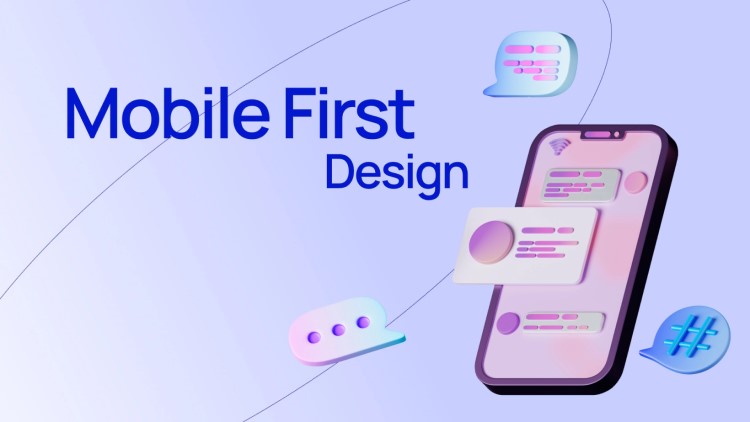
What is Mobile-First Design?
Mobile-first design is a strategy that prioritizes designing for mobile devices before adapting the design for larger screens like desktops. This approach recognizes the growing number of users who access websites primarily through smartphones and tablets. By starting with mobile, businesses can focus on creating simple, streamlined interfaces that are easy to navigate on smaller screens. This reduces clutter and ensures that key features are accessible to mobile users.
The impact of mobile-first designs on user experience is significant. Unlike traditional web design, which starts with desktop and scales down, mobile-first design considers the limitations of mobile devices, such as screen size and data speed. It leads to faster load times and cleaner layouts. As a result, users have a smoother, more satisfying experience that encourages them to stay longer and engage more with your content.
This approach also aligns with modern consumer behavior. With the shift toward mobile browsing, adopting mobile-first strategies allows you to meet your audience where they are. The impact of mobile-first designs on your business is clear: it improves usability, enhances customer satisfaction, and increases the likelihood of conversion.
Mobile-First Design and User Experience (UX)
Mobile-first design enhances user experience by focusing on simplicity, speed, and convenience. By designing for mobile devices first, you prioritize what matters most to users—quick load times and easy navigation. This approach eliminates unnecessary clutter, helping users find what they need faster and with less effort.
Another key impact of mobile-first designs is the improvement in page load speed. Mobile users typically have less bandwidth, and slow loading times can frustrate them. Mobile-first design optimizes images, reduces page elements, and ensures faster performance. When pages load quickly, users are more likely to stay and engage with your content.
Lastly, mobile-first design prioritizes convenience. With intuitive layouts and simple touch navigation, users can interact seamlessly with your site. The impact of mobile-first designs is evident in the way they cater to on-the-go users, improving overall satisfaction and increasing retention.
Influence on Consumer Purchasing Decisions
The impact of mobile-first designs on consumer purchasing decisions is significant. Mobile-optimized interfaces encourage impulse buying by streamlining the purchasing process. When your site is easy to navigate and fast to load, consumers are more likely to make quick decisions without distractions. The simplicity of a mobile-first design removes barriers, allowing users to move seamlessly from browsing to checkout.
Mobile-first designs also speed up decision-making. Consumers expect fast and convenient experiences, especially when shopping online. By minimizing page load times and simplifying product information, you help users make quicker purchase choices. A mobile-optimized site means less time searching and more time buying, which positively affects sales.
Finally, the convenience of mobile-first designs fosters customer loyalty. When users experience a smooth, frustration-free interaction with your site, they are more likely to return. The impact of mobile-first designs is clear in creating a positive shopping experience that builds long-term trust and repeat business.
Mobile Search Behavior and SEO Implications
The impact of mobile-first designs on search behavior and SEO is profound. Google’s mobile-first indexing prioritizes websites that are optimized for mobile devices, which means your site’s mobile experience directly affects search rankings. If your site isn’t mobile-friendly, you risk losing visibility in search results. A well-designed mobile interface can improve discoverability and drive more organic traffic.
Mobile-first designs also shape how consumers search for products and services. Most users now conduct searches on mobile devices, expecting fast load times and easy navigation. If your site is slow or difficult to use on a phone, users may leave quickly, increasing bounce rates. This behavior signals to search engines that your site isn’t providing a good user experience, which can lower your ranking.
Additionally, mobile-friendly sites tend to rank higher due to improved usability and lower bounce rates. The simplicity and speed of mobile-first designs make it easier for users to find what they’re looking for, increasing engagement and boosting SEO performance. The impact of mobile-first designs extends beyond aesthetics, influencing both search behavior and search engine optimization.
Social Media Integration in Mobile-First Designs
The impact of mobile-first designs on social media integration is significant. Seamless integration of social platforms into mobile interfaces enhances user engagement by allowing users to share content effortlessly. When your website or app incorporates social sharing buttons that are easy to find and use, users are more likely to interact with your brand and amplify your reach.
Social media integration also fosters stronger connections between users and brands. With mobile-first designs, users can easily log in using social accounts, which streamlines the user experience. This encourages more frequent interaction, whether through likes, shares, or comments, driving engagement and fostering loyalty. The simplicity of mobile-first design makes these interactions feel natural and effortless.
Additionally, integrating social media into mobile interfaces enables businesses to capitalize on real-time engagement. Features like instant social sharing, mobile-friendly widgets, and embedded content keep users engaged and informed. The impact of mobile-first designs in this area is clear: it facilitates ongoing conversations and strengthens the relationship between users and brands.
Challenges and Solutions in Adopting Mobile-First Design
Transitioning to mobile-first design poses several technical and strategic challenges for businesses. One of the primary issues is ensuring that websites and apps remain responsive across all devices. This requires optimizing content, images, and functionality for smaller screens without sacrificing user experience. To overcome this, you should focus on simplifying layouts and removing unnecessary elements that could slow down performance on mobile devices.
Another challenge involves redesigning legacy systems that weren’t built with mobile use in mind. Many businesses rely on older infrastructure, which can complicate the process of adopting mobile-first approaches. The solution here involves investing in modern development frameworks and conducting thorough testing to ensure compatibility across different platforms. Upgrading your systems gradually can ease the transition without disrupting daily operations.
Additionally, strategic adjustments are necessary when considering the Impact of Mobile-First Designs on customer behavior. Mobile users expect faster load times and intuitive interfaces, so it’s essential to prioritize user experience in your mobile-first strategy. Ensuring that navigation is simple and content is easily accessible will improve engagement and retention, making the shift to mobile-first more effective.
Conclusion
The Impact of Mobile-First Designs on consumer behavior is undeniable, influencing everything from purchasing decisions to online engagement. As mobile usage continues to grow, you need to prioritize this design approach to stay competitive. A well-executed mobile-first strategy enhances user experience, improves search rankings, and increases customer loyalty. By focusing on simplicity and speed, you can meet the expectations of today’s mobile users. As you move forward, consider the benefits as well as challenges of adopting a mobile-first approach, ensuring your business remains adaptable in an increasingly mobile-driven world.


